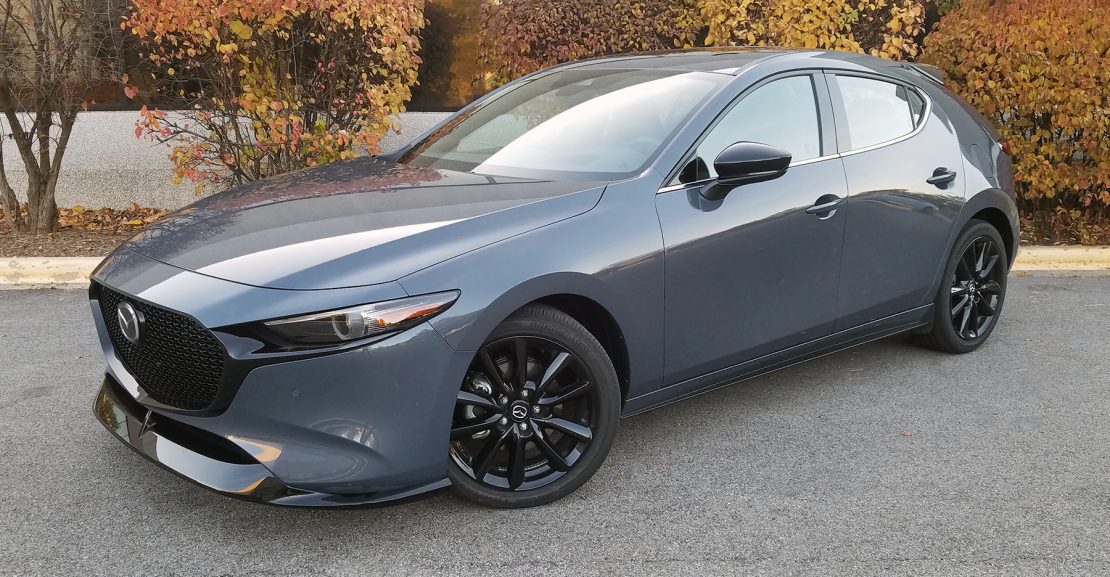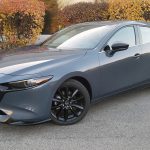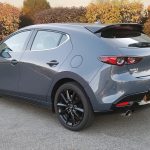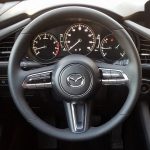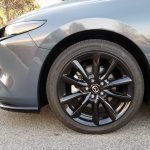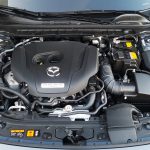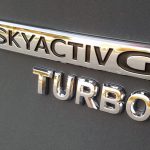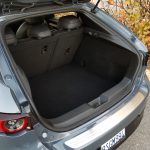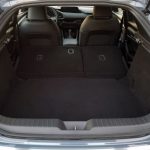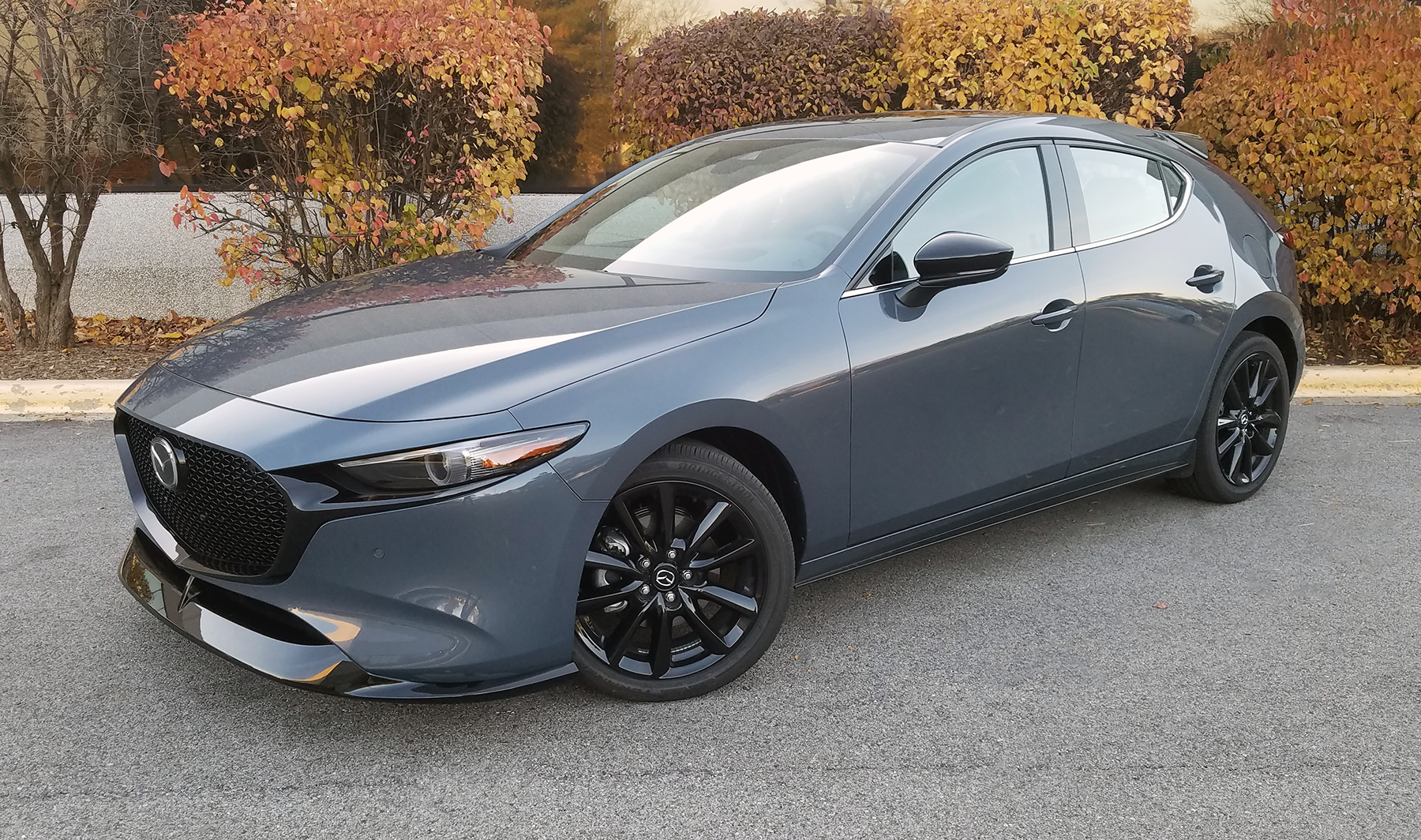
 When the Mazda 3 lineup was redesigned for the 2019 model year, Mazda gave its sporty compact hatchback and sedan lots of new stuff: sleek new styling (with a striking bobtailed shape for the hatchback body style), new technology features, a notably more upscale look and feel, and, for the first time, the availability of all-wheel drive. What the 2019 Mazda 3 DIDN’T get, however, was more horsepower or a new engine—its sole powerplant was a 186-hp 2.5-liter 4-cylinder that was carried over from the previous-generation 3.
When the Mazda 3 lineup was redesigned for the 2019 model year, Mazda gave its sporty compact hatchback and sedan lots of new stuff: sleek new styling (with a striking bobtailed shape for the hatchback body style), new technology features, a notably more upscale look and feel, and, for the first time, the availability of all-wheel drive. What the 2019 Mazda 3 DIDN’T get, however, was more horsepower or a new engine—its sole powerplant was a 186-hp 2.5-liter 4-cylinder that was carried over from the previous-generation 3.
That changes for 2021, as the 3 gets two newly available engines in addition to the existing naturally aspirated 2.5. There’s now a base 2.0-liter 4-cylinder that makes 155 horsepower and 150 pound-feet of torque, and (our main focus here) a turbocharged 2.5-liter 4-cylinder engine that’s rated at 250 horsepower and 320 lb-ft of torque on premium gasoline, and 227 hp and 310 lb-ft of torque when running on regular gas.
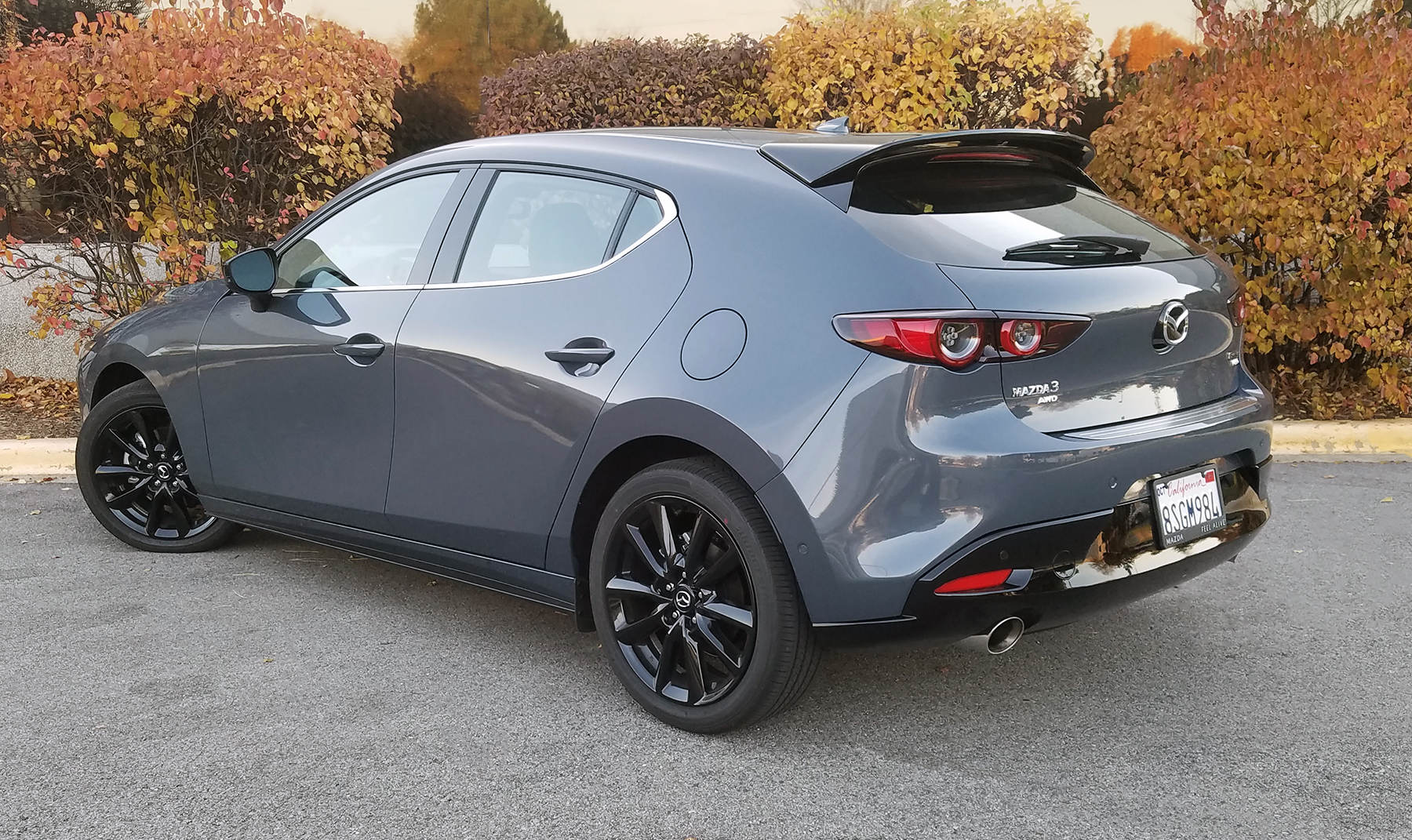
The 2.0-liter four engine (which is available only with the front-wheel-drive sedan) enables Mazda to offer the 3 at a slightly lower starting price. The turbo 2.5, however, is fully in step with Mazda’s ambitions to reposition itself as a premium brand. It’s only available in a topline 2.5 Turbo trim level that comes standard with all-wheel drive and upscale trim.
And, let’s get this out of the way too—the 2.5 Turbo’s sole transmission is a 6-speed automatic with steering-wheel-mounted paddle shifters. Though we can hear the moans of traditional enthusiast drivers from here, the economic case for engineering and certifying a manual transmission just doesn’t pencil out, given the limited sales potential of manuals in today’s market. The good news is that the steering-wheel paddle shifters here are some of the best we’ve used; they summon quick upshifts and downshifts—the latter is just the ticket when you’re heading into a corner.
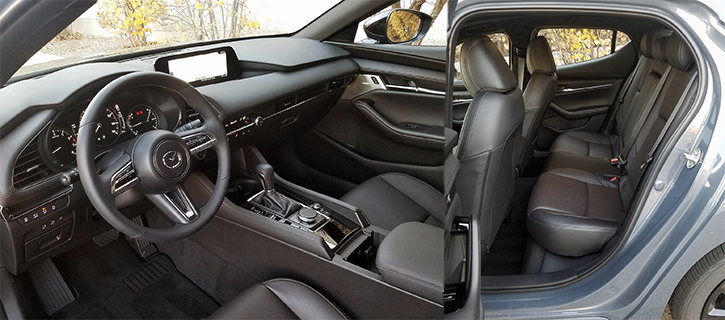
While we’re talking about hardcore enthusiasts: If you were hoping that this new powered-up Mazda 3 would be a revival of the raucous 2007-2013 Mazdaspeed 3… well, it’s not. Instead of a stiff-riding, uncompromising hot rod that’s tuned for at-the-limits driving at a track day or autocross, the 2.5 Turbo has been engineered to feel nimble, poised, and responsive in everyday driving situations. With this car, Mazda engineers aren’t chasing numbers on a spec sheet—they’re more interested in the seat-of-the-pants feel and an everyday-pleasurable driving experience. Mazda likes to call this “Jinbai Ittai” (a Japanese term to describe the unity between a horse and rider), and the goal with the 2.5 Turbo was a grown-up version of this feeling.
The turbo engine is the same basic powerplant that’s used in Mazda’s CX-5 and CX-9 SUVs and the Mazda 6 midsize sedan, but engineers made a few minor packaging changes, such as a redesigned air intake tract and switch from an air-to-air turbo intercooler to an air-to-water unit, for use in the smaller 3 chassis.
First Spin: 2021 Hyundai Elantra
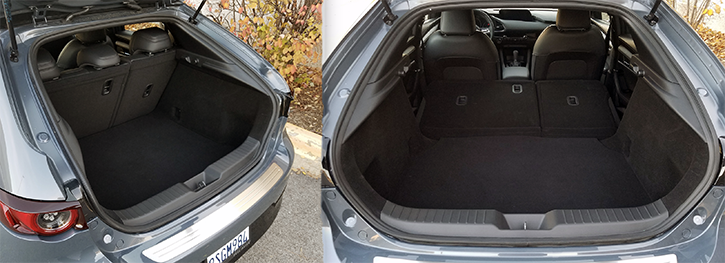
Mazda engineers also aimed to give the 2.5 Turbo engine the power-delivery characteristics and feel of a naturally aspirated V6. Based on our test-drive experience… mission accomplished. The power delivery is wonderfully smooth and linear. Turbo lag is basically non-existent, and the low-end torque is respectable as well, with decent “pull” below 4000 rpm. A 6-speed automatic transmission is already something of an anachronism in today’s market of CVTs and 7-,8-,9-, and 10-speed gearboxes, but the 3’s automatic is a polished partner to the turbo engine. It’s wonderfully responsive, and as mentioned above, the excellent paddle shifters provide a higher level of driver control if you’re so inclined.
The engine’s exhaust note is nice for a 4-cylinder, but no one will mistake it for an exotic powerplant or a performance-tuned V6. And again, in keeping with the upscale aim of this car, the engine noise is so nicely muted that it almost never intrudes. Some buyers might consider it almost TOO quiet for an enthusiast-oriented car.
Quick Spin: 2020 Volkswagen Jetta SEL Premium

The 2.5 Turbo’s EPA fuel-economy ratings are 23 mpg city/31 highway/26 combined in hatchback form, and 23/32/27 in sedan form… those combined numbers are just one mpg less than the comparable non-turbo 2.5 models. In a test that consisted of 114 miles of about 65 percent city driving, we averaged 24.0 mpg—on par with the EPA estimates.
Mazda slightly retuned the 2.5 Turbo’s suspension to compensate for the extra weight of the turbo engine, and retuned the steering to deliver a bit more feedback, but the overall focus was on everyday ride composure as much as absolute cornering prowess—aggressive sport suspension tuning wasn’t part of the program. That’s fine by us; the Mazda 3 is already one of the best-handling mainstream compact cars. The standard suspension setup offers a darn-near ideal mix of handling acumen and bump absorption for a compact car.
Quick Spin: 2020 Toyota Corolla Hybrid LE

Likewise, the steering feel is wonderfully balanced; it’s smooth and offers excellent communication and feedback for a connected feel. Mazda engineers are intensely focused on “human-centric” chassis tuning. They studied natural human motions and muscle reactions to dial in a “minimum-jerk” feel to the 3’s steering, for an “organic” response to the driver’s inputs and to minimize the need for mid-corner steering corrections. Also aiding in this natural feel is Mazda’s G Vectoring Control system, which varies engine torque in response to steering inputs to subtly shift weight to the front wheels for better cornering performance and ride stability. The 2.5 Turbo’s GVC-system settings are changed for crisper performance when the driver selects the Sport drive mode.
Despite the changes under the skin, 2.5 Turbo’s exterior styling tweaks are subtle… essentially blacked-out trim elements, a larger exhaust pipe, a turbo badge on the decklid or hatch, and an available front air dam and rear spoiler on the hatchback body style.
Base versions of the Mazda 3 compete against mainstream rivals such as the Honda Civic and Toyota Corolla, but Mazda hopes that the 2.5 Turbo might snag customers who are shopping entry-level luxury-brand compacts such as the Acura ILX, Audi A3, and Mercedes-Benz A-Class. And measured against those cars, the 2.5 Turbo stacks up very well. The base MSRP of the 2.5 Turbo sedan is $29,990, and the hatchback is $1000 more. Our hatchback test vehicle was equipped with the Premium Plus Package, which bumps up the starting price to $33,750 and includes a host of premium features (the asterisked items are new this year):
Test Drive: 2020 Nissan Sentra SR Premium
- leather upholstery
- front and rear parking sensors
- 360-degree-view monitor (newly upgraded to all-digital system, with view-mode selector button)
- Traffic Jam Assist (adds slow-traffic steering assist at 0-40 mph)*
- auto-dimming exterior mirror
- traffic sign recognition
- front air dam
- Mazda navigation system with 3-year traffic and Travel Link trial
- Rear Smart City Brake Support*
- rear cross-traffic braking*
- HomeLink universal garage door opener
- black rear-hatch-mounted spoiler
Tack on the $945 destination fee and a $125 stainless rear bumper guard, and the bottom line of our test vehicle was $34,820… steep for a mainstream-brand compact car, but very competitive with the luxury-brand competitors to which the 2.5 Turbo favorably compares.
Our main gripes with the Mazda 3 remain the cramped rear-seat space and the so-so rear visibility in the hatchback models. With many buyers continuing to shift to crossover SUVs, the remaining passenger cars are now focusing more on sportiness and handling than practicality (Mazda reps told us that buyers concerned with rear-seat space and cargo volume can opt for its CX-30 compact SUV). And, while we’re being pampered, we wish the 3 offered ventilated front seats in addition to its heated seats.
Still, Mazda hit the target it set for itself with the 3 2.5 Turbo—the horsepower infusion changes the character of the basic 3, and legitimates pushes the car further upscale. And even though it’s counter to Mazda’s brand-positioning goals, we would welcome a de-contented version that makes the goodness of the turbo engine available at a lower price point.
Test Drive: 2019 Honda Insight Touring
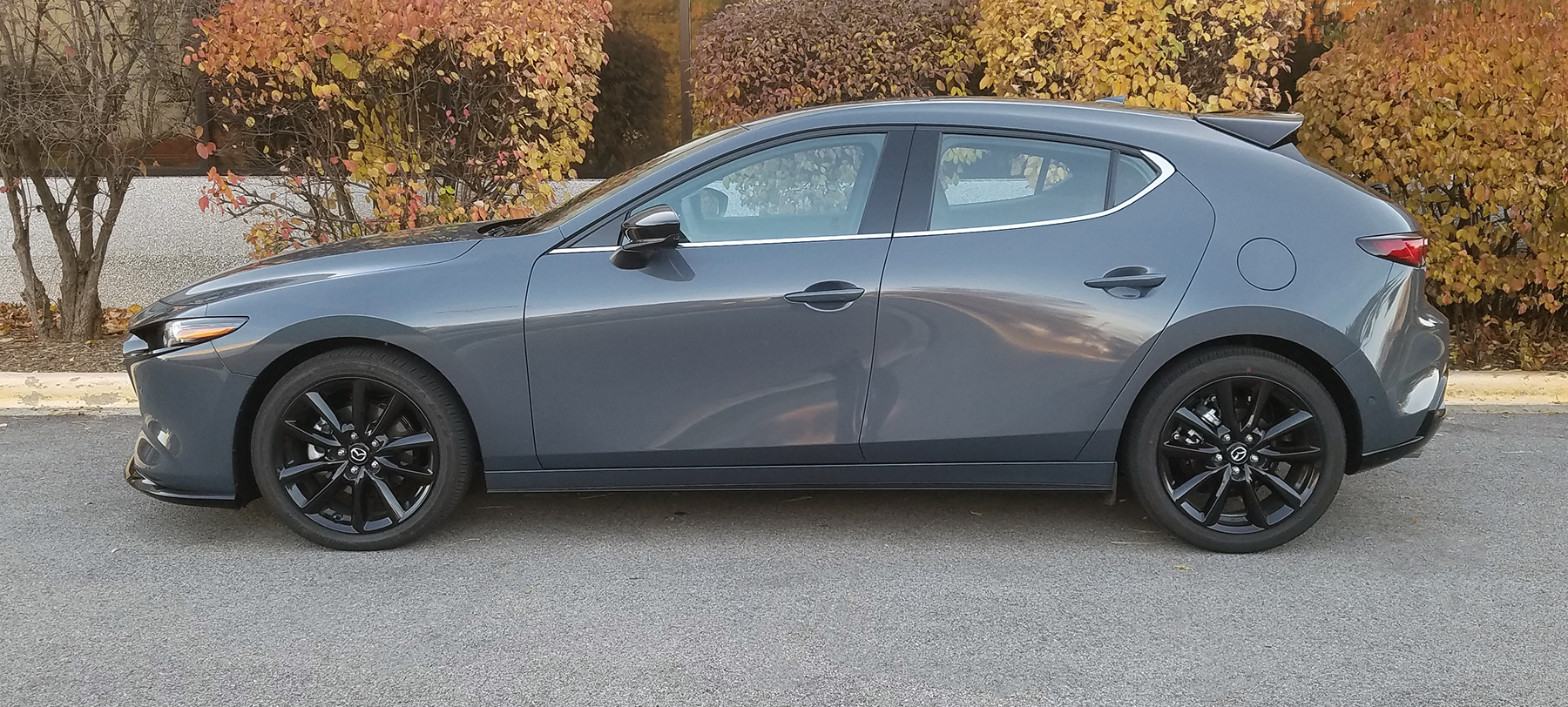
(Click gallery pics below for enlarged images)
Listen to the very entertaining Consumer Guide Car Stuff Podcast

